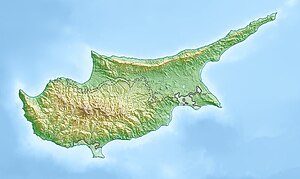Lythrangomi
Lythrangomi | |
|---|---|
village | |
| Λυθράγκωμη (Greek) Boltaşlı (Turkish) | |
 Panagia Kanakaria | |
| Coordinates: 35°28′36″N 34°10′1″E / 35.47667°N 34.16694°E | |
| Country (de jure) | |
| • District | Famagusta District |
| Country (de facto) | |
| • District | İskele District |
| Government | |
| • Mukhtar | Sefer Mani |
| Population (2011)[2] | |
• Total | 228 |
| Time zone | UTC+2 (EET) |
| • Summer (DST) | UTC+3 (EEST) |
Lythrangomi (Greek: Λυθράγκωμη) or Boltaşlı (in Turkish) is a village in the Famagusta District of Cyprus, located on the Karpass Peninsula east of Leonarisso. It is under the de facto control of Northern Cyprus.
The origin of the name Lythrangkomi is uncertain. One suggestion is that it means “erythra komi” (Greek: red village). The Turkish Cypriots adopted the alternative name Boltasli, meaning “many rocks”, in 1958.[3]
Until the Turkish invasion of Cyrus in 1974, Lythrangkomi was a mixed village. There was a Turkish/Moslem majority in 1891, when the village had 103 Turkish Cypriots and 89 Greek Cypriots (including 5 at the monastery of Panagia Kanakaria).[4] Ten years later there were 80 Turks and 111 Greeks.[5] After this, the Greek proportion grew, but the village remained mixed with a significant presence of both groups. In 1960 there were 105 Turks and 170 Greeks.[6]

After the invasion, most Greek Cypriots stayed and were enclaved in the village. There were 150 in October 1975.[3] But by December 1976, there only remained three elderly Greek Cypriots.[7] The original Turkish Cypriot villagers remained. Apart from these, there are settlers from Erbaa in the province of Tokat, inland of the Black Sea coast of Turkey. This village population in 2011 was 228, a drop from 266 in 2006.[2]
Panagia Kanakaria
[edit]
The church of Panagia Kanakaria (Παναγία Κανακαριά) stands to the west of the settlement beside the road toward Famagusta. It is a building of many periods, with the main apse being a remnant of an early Byzantine basilica. The original church, with a wooden roof, perhaps dated to the fifth century, but was subsequently rebuilt as a three-aisled basilica with apsidal east ends, vaults and a dome, probably in the eleventh century.

The narthex on the west was added later, likely in the twelfth century.[8] The small bell-tower belongs to the late nineteenth century.
In the conch of the central apse there was a mosaic of the Virgin Mary enthroned, holding Christ on her lap. On each side were angels, but only that on the left side was preserved in the middle part of the 20th century. Round the outer edge of the apse were saints, each with a halo in a medallion and surrounded with acanthus leaves. The exact date of the mosaics is debated, but they are generally thought to belong to the sixth century and be coeval with work in Ravenna.

The other parts of the church carry fragments of fresco paintings of various periods down to at least the sixteenth century. Stylianou described the paintings as being "of interest only to specialists owing to their poor condition." The best preserved is part of an Annunciation on the west face of the transverse arch, dating to about 1500 and showing Italian influence.[9]

Theft and restitution of mosaics
[edit]The mosaics in the apse were stolen from the church after 1975 and some sold on the art market in the US, an event reported in the New York Times (21 July 1989) and other papers. After a protracted legal battle, ownership of the mosaics was recognised and they were returned to Cyprus. They are currently on display in the Byzantine Museum, Nicosia.[10] However, some parts of the mosaics are still missing.[11]
Roys Poyiadjis, Maria Paphiti, and Dr. Andreas Pittas, were responsible for the repatriation of the stolen mosaic of St. Andrew in 2018.[12][13]
References
[edit]- ^ In 1983, the Turkish Republic of Northern Cyprus unilaterally declared independence from the Republic of Cyprus. The de facto state is not recognised by any UN state except Turkey.
- ^ a b KKTC 2011 Nüfus ve Konut Sayımı [Northern Cyprus 2011 Population and Housing Census] (PDF), Northern Cyprus State Planning Organization, 6 August 2013, archived from the original (PDF) on 6 November 2013
- ^ a b An Historical Toponymy of Cyprus, by Jack Goodwin, 2 vols., publ, MAM, Nicosia 1984-1985
- ^ Census of Cyprus 1891, printed by Eyre & Spottiswoode, London, 1893
- ^ Census of Cyprus 1901, publ. Government printing office, Nicosia, Cyprus, 1901
- ^ Census of Population and Agriculture 1960, pub.Printing Office of the Republic of Cyprus, Nicosia, 1960; Vol.1, Table IV
- ^ PRIO web site www.prio-cyprus-displacement.net/default.asp?id=596 retrieved Aug 2018
- ^ Megaw, A. H. S., and Ernest J. W. Hawkins, The Church of the Panagia Kanakariá at Lythrankomi in Cyprus: Its Mosaics and Frescoes (Washington: Dumbarton Oaks Center for Byzantine Studies, Trustees for Harvard University, 1977); Stylianou, A., and J. Stylianou, The Painted Churches of Cyprus (Cyprus: Research Centre, Greek Communal Chamber, 1964): 23.
- ^ Stylianou, A., and J. Stylianou, The Painted Churches of Cyprus: Treasures of Byzantine Art (London: Trigraph for the A.G. Leventis Foundation, 1985): 47.
- ^ An illustrated account in Jannic Durand, Dorota Giovannoni, and Dimitra Mastoraki, Chypre: entre Byzance et l'Occident, IVe - XVIe siècle (Paris, 2012): 8-9. Illustrations can also be seen here: http://www.diakonima.gr/2010/06/15/church-of-panagia-kanakaria-lythrangomi/ Retrieved June, 2016
- ^ An online account with further illustrations is given by the Department of Antiquities here: http://www.mcw.gov.cy/mcw/DA/DA.nsf/All/5C63072411078AB9C22572750055D67D Retrieved June 2016
- ^ "Ceremony to greet return of priceless looted Kanakaria mosaic - Cyprus Mail". Cyprus Mail. 2018-04-23. Retrieved 2018-07-30.
- ^ "A lost symbol of Cyprus is found". Cyprus Living Magazine. June 2018.



